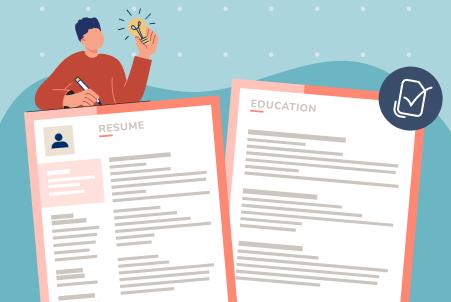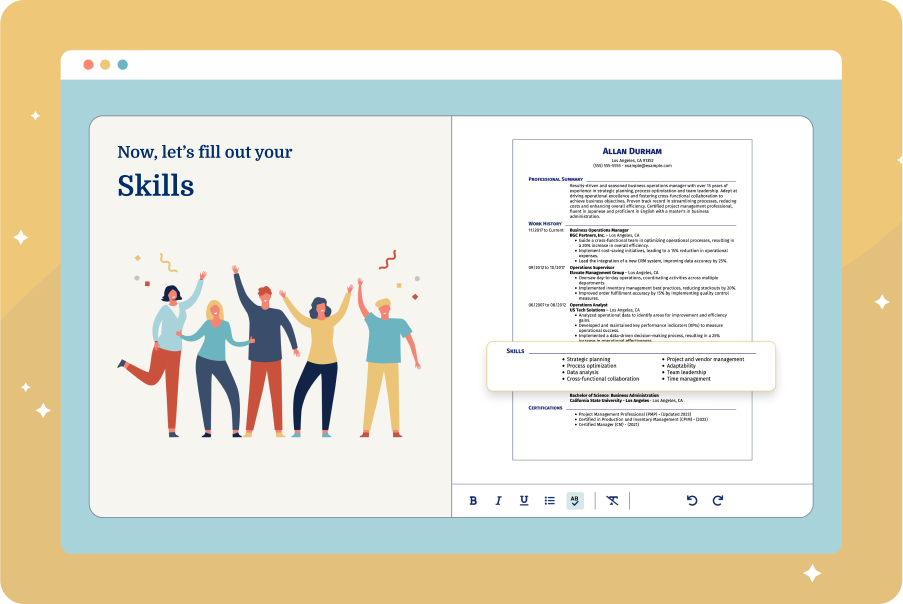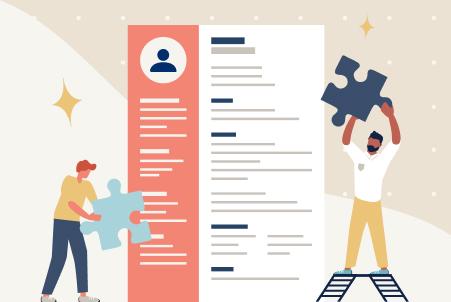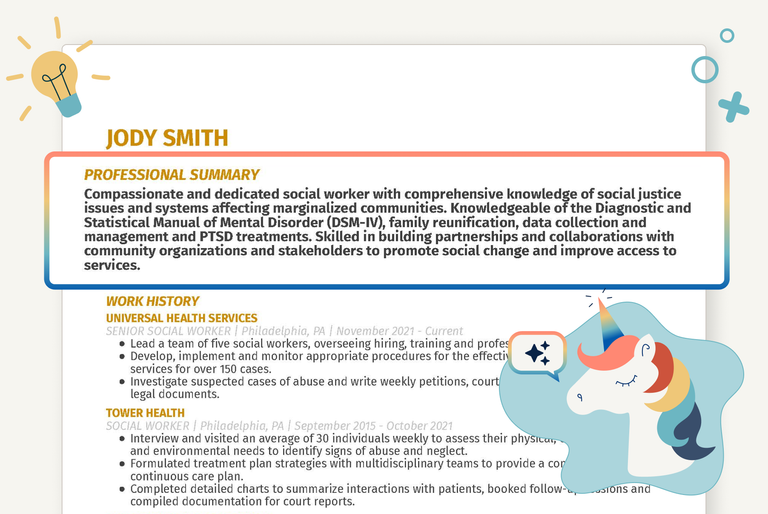One-Page Resume Guide: Templates & Examples

Our customers have been hired at: *Foot Note
The question of whether a resume should be limited to a single page has long been a topic of debate among job seekers and career experts.
In this guide, we’ll delve into key considerations for deciding between a one or two-page resume and provide professionally crafted one-page resume examples to help you build your job-winning resume.
While a one-page resume is often preferred for entry or mid-level positions, a two-page resume is acceptable if you have extensive experience and accomplishments directly related to the role you are applying for.
Does a Resume Have to Be One Page?
While a one-page resume is ideal for many roles, industries and career stages, it is not a strict requirement (unless specified in the job description).
The length of your resume should be determined by the content's relevance and impact rather than trying to fit your skills and qualifications into a single page.
If you have extensive work experience, quantifiable accomplishments and additional qualifications worth showcasing, extending your resume to two pages may be appropriate.
It's important to consider the specific requirements and preferences of the company or industry you are applying to and to prioritize the most important information on the first page.
Benefits of One-Page Resumes
While your resume does not have to be one page, there are certainly benefits to writing a resume that fits on a single page. We’ve detailed the advantages of one-page resumes below:
- Time constraints: Hiring managers often have limited time to review each application. A one-page resume allows them to quickly scan and evaluate your skills and work history without getting overwhelmed by excessive information.
- Clarity and focus: A one-page resume encourages you to be clear and focused in presenting your qualifications, ensuring that the most important details stand out.
- ATS compatibility: Many companies use applicant tracking systems (ATS) to scan and filter resumes. One-page resumes tend to be ATS-friendly, as they are less likely to encounter issues with formatting and compatibility.
- Visual impact: With limited space, you can pay more attention to the design and visual appeal of your one-page resume, making it visually engaging and memorable.
Use our free ATS resume checker to scan your resume for 30+ common errors and receive instant feedback on improving your resume score.
One-Page Resume Templates
Explore the professionally crafted single-page resume templates below to take the guesswork out of designing your resume.
Should a Resume Be One Page or Two Pages?
The one-page resume has long been hailed as the gold standard for its simplicity and brevity, appealing to busy hiring managers with limited time to review applications.
However, as careers become more complex and candidates accumulate diverse experiences, there is less pressure to condense achievements onto a single page.
The decision of whether your resume should be one page or two pages depends on several factors, including your level of experience, the industry you're applying to and the specific job requirements.
We’ve detailed a few key considerations when deciding between a one-page resume and a two-page resume to help you decide which one is right for you.
Level of experience
Hiring managers may only spend a few seconds reviewing each resume, and a concise, one-page document makes it easier for them to assess your professional skills and qualifications quickly.
If you have less than 10 years of professional experience or are a recent graduate, we recommend keeping your resume to one page.
If you have over 10 years of experience or have held multiple positions, you may need a two-page resume to adequately showcase your relevant skills and accomplishments.
In this case, it's crucial to ensure that the second page adds value and contains information that is directly relevant to the job you are applying for.
Industry norms
Some industries, such as academia or research, may expect longer resumes as they often require more detailed information, such as publications, presentations or research projects.
We also recommend exploring resumes versus CVs to determine which job application document best suits your field and career level.
Conversely, industries like design or marketing may prioritize a shorter, visually appealing one-page resume.
Research industry norms and consider what is expected in your field when deciding on the length of your resume.
Job requirements
Carefully review the job description and requirements to determine the most relevant information for the position.
Tailor your resume accordingly, focusing on the skills and experiences that align directly with the job. A targeted resume is much more likely to grab the hiring manager's attention.
If you find that including this information exceeds one page, extending your resume to two pages may be necessary. Remember to use keywords from the job description in your resume.
How to Fit a Resume on One Page
There are a number of formatting and content tricks that you can use if you would prefer to condense your resume down to one page. Here are a few tips on how to make a resume one page:
- Include a catchy headline: Feature a compelling resume headline above your professional summary to quickly highlight your value.
- Shorten your summary: Replace lengthy paragraphs with a two to four-sentence resume summary or objective statement to highlight your most relevant qualifications.
- Use the "last 10 years" rule: Include only the most recent and relevant 10 years of experience, focusing on describing your accomplishments and the impact you made in each role.
- Omit irrelevant information: Consider removing older or less significant positions, coursework or certifications that may be taking up valuable space.
- Single-line bullets: Stick to three to five bullet points per job and limit bullet points to one line. Combine similar bullet points or achievements into one sentence.
- Adjust the font size: Use a legible resume font that is easy to read, and reduce the size to as low as 10 points to help fit everything on the page.
- Modify margins and spacing: To maximize space, consider reducing the margins or adjusting line spacing. However, do not reduce margins to less than half an inch.
- Combine and condense sections: For example, combine technical skills and soft skills into a concise, bulleted list or incorporate them into descriptions.
- Use concise language: Remove phrases like “responsible for” or “assisted with” and start with strong action verbs (e.g., “managed,” “developed,” “improved”).
One-Page Resume Builder
Our Resume Builder makes it easy to make a one-page resume in minutes. Select a template and follow the step-by-step prompts to enter your professional skills and background.
You’ll get tips and ready-made content suggestions from Professional Resume Analysts for each section of your resume.
You can preview your resume to ensure that the content fits on a single page and adjust the template as needed, such as changing the font size or type and adjusting the sections.
We also recommend browsing our library of 800+ resume examples to get inspired by real-world resumes for different jobs, industries and career levels.
What to Leave Off a One-Page Resume
When creating a one-page resume, it's important to prioritize the most relevant information and leave off any details that don't directly contribute to your qualifications for the job.
Here are some details to consider leaving off of your one-page resume:
- Irrelevant work experience: If you have had past work experience that is not directly related to the job you are applying for, consider leaving it off.
- Personal information: Information such as your age, marital status or religious affiliation is generally unnecessary and may even be considered discriminatory.
- References: It's not necessary to include references on your resume. Instead, have a separate list of references ready upon request.
- Hobbies and interests: While it's good to showcase your personality, hobbies and interests are generally not relevant to the job and can take up valuable space on a one-page resume.
- High school education: Do not include high school in your education section unless you are a recent graduate or your high school education is directly relevant to the job.
- Unrelated skills: Avoid listing hard skills or soft skills that are not directly relevant to the job you are applying for.
One-Page Resume Format
Your single-page resume format should be clean, simple and easy to read. Here are a few tips to keep in mind while you format your resume:
- Use a legible font that is easy to read, such as Arial, Calibri or Times New Roman. Use a slightly larger font size for headers and keep the sizing consistent throughout.
- Use bullet points to break up long paragraphs and make the content easier to skim. To stand out, consider including a bulleted resume profile.
- Use clear headings and subheadings to organize your content and make it easier to navigate.
- Include white space between sections to make the resume less cluttered and more visually appealing.
- Use bold or italicized text to emphasize important information, such as job titles or accomplishments.
- Use a consistent format throughout the resume, including font size, spacing and margins.
- Consider using a simple, professional design element, such as a light-colored header or border, to add visual interest without distracting from the content.
The layout of your resume will also depend on the resume format you use. Below is a breakdown of the three main resume formats:
Regardless of the format, hiring managers prefer resumes that clearly highlight relevant skills and accomplishments, making it easy to see you're a great fit for the role.- Dr. Jasmine Escalera, Career Expert
One-Page Resume Writing Tips
- Prioritize quality over quantity: Focus on including the most relevant and impactful information rather than trying to fill up space. Quality content is more important than sheer length
- Be concise: Use clear and concise language to convey your qualifications and experiences. Avoid long paragraphs and unnecessary details.
- Format effectively: Organize your resume in a clean and easy-to-read manner. Use bullet points, headings and white space to make it visually appealing and skimmable.
- Tailor your resume: Customize your resume for each job application, highlighting the most relevant skills and experiences that align with the specific role.
Key takeaways
- A one-page resume can be highly effective in capturing the attention of hiring managers, as it forces you to prioritize and condense your most relevant and impactful information.
- It's important to consider the specific requirements and preferences of the company or industry you are applying to when deciding between a one-page and two-page resume.
- Using concise language, adjusting the font size, and editing carefully are key strategies when creating a clear and professional one-page resume.
- The length of your resume should be determined by the content's relevance and impact rather than trying to fit it into a specific page count.
FAQ
Does a resume have to be one page?
No, a resume doesn’t have to be one page, but it’s ideal for most professionals, especially those with less than 10 years of experience.
A one-page resume is concise, easy to scan, and forces you to highlight your most relevant achievements.
However, if you have extensive experience, certifications or specialized skills, a two-page resume is acceptable, as long as the content remains clear and relevant.
Do recruiters prefer a one-page resume?
Recruiters’ preferences for resume length and what your resume should look like can vary depending on the industry, position and the seniority level of the role.
Many prefer one-page resumes for entry-level and early-career positions because they are concise and easy to read.
For additional considerations, see our guide on how to make a resume with no experience.
However, a longer two-page resume may be more appropriate for more senior-level positions or roles that require extensive experience or a diverse skill set.
Is it okay to have a two-page resume?
Absolutely! It is okay to have a two-page resume, especially if you have extensive work experience, education or relevant skills to showcase.
However, remember that hiring managers may not have the time to read through a lengthy document, so it is important to be strategic in structuring and formatting your resume.
Focus on your most recent and relevant experience, and try to keep your older work history to a minimum. See what to put on a resume for additional guidance on what to include.
In some countries, it is common for resumes to span beyond two pages. For instance, an Australian resume is expected to be anywhere from two to five pages.
Does the one-page resume rule still apply?
The rule that a resume must be one page does not always apply to U.S. resume format best practices.
While resume length is somewhat flexible, particularly for more experienced professionals, a well-crafted one-page resume is highly effective in capturing the attention of hiring managers.
A one-page resume forces you to prioritize and condense your most relevant and impactful information, making it easier for recruiters and hiring managers to assess your qualifications.
Ultimately, the length of your resume should be determined by the content and relevance of your experience rather than a strict rule about page count.
See our resume “About Me” examples for guidance on introducing yourself succinctly and effectively in your one-page resume.
Is a 1.5-page resume okay?
A one-and-a-half-page resume can create visual imbalance, especially if the second page contains only a small amount of information.
If your resume is one and a half pages long, we recommend reducing it to a single page or adding relevant and high-quality content to fill two complete pages.
To shorten your resume, consider removing older or less significant positions, coursework or certifications and adjusting formatting, spacing or font size to help fit everything onto one page.
If you have extensive work experience, relevant accomplishments or additional qualifications worth showcasing, you may consider extending your resume to two full pages.
Ensure that the information you include is truly valuable and relevant to the position you are applying for.
Avoid stretching the content to fill the space just to reach two pages. Use a resume outline to keep track of your career accomplishments and decide which ones are worth including.
How we reviewed this article
Since 2012, we have helped more than 11 million job seekers. We want to make your career journey accessible and manageable through our services and Career Center’s how-to guides and tips. In our commitment to bring you a transparent process, we present our Editorial Process.
Sources
- CNBC. Article. Malinsky, Gili. How long a resume should be, according to experts
Our customers have been hired at:*Foot Note











